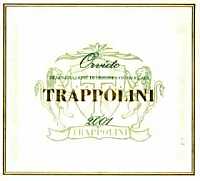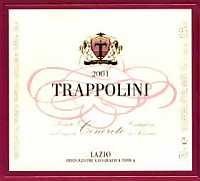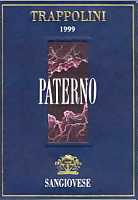|
In the general trend of the wine industry, where the so called
“international” grapes are widely used, it is not easy to find a winery which
believes, with no hesitation, in the richness and potentiality of local grapes
and, last but not least, getting excellent results. Trappolini winery is
certainly one which belongs to this category; a production completely based on
local grapes, with the only exception of a wine which is produced with
Chardonnay, and the richness of the grape patrimony of their lands. Trappolini
winery is located in Castiglione in Teverina, a characteristic town in the
province of Viterbo, few kilometers far from the Umbrian border and,
enographically speaking, located in the Orvieto wine area.
|
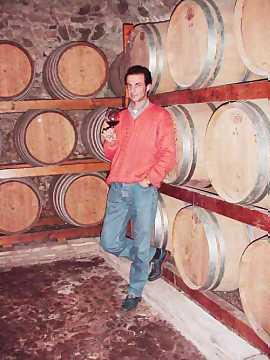 | |
| Mr. Roberto Trappolini in his cellar | |
|
As we get to the winery we meet Mr. Roberto Trappolini, managing director of
the winery, who introduced us to some historical and productive aspects of the
business «the winery was established in the sixties of the past century and it
was my grandfather to start the business and later my father joined him. In the
beginning of our business, quality, as we consider it now, it was not a primary
productive strategy of the winery, things changed with time and we changed our
business from wine sellers to quality wine producers. After forty years we
developed our production and commercial line and we are convinced in going to
this direction while trying to improve the quality of our production, from
vineyard to sales. The winery is located in the largest commune of Latium
region and which is permitted to produce an Umbrian DOC wine, Orvieto, a
product which allowed us to have a rapid improvement of the local enology,
however, things changed with time because the main requests for the Orvieto
wine was related to Orvieto Classico and being outside of the
“classic” production area, we have been forced, in a sense, to get back and
strongly reconsider our origins and our territory. Our land is suited for the
cultivation of red berried grapes, mainly historical and typical for this area,
such as Sangiovese and Aleatico, as well as white berried grapes, that we also
use to make our Orvieto, and the most important one of them all is Grechetto.
We obviously are interested in the red berried grapes which have historically
been present in this territory, such as Sangiovese, and other that are
unfortunately not considered and are disappearing as few producers make wine
from them, such as Aleatico and Canaiolo. These grapes are part of our rich
enological patrimony and we thought it was not good to abandon them and we
believed in keep using them, particularly Aleatico which we use to make a very
refined and particular sweet wine without making use of other and more famous
grapes. By using this grape we produced our newest wine: Idea. Its production
is made by using the same grape species and by using a rather complex process:
harvest is done in two different phases, the first one of them allow us to
harvest sound grapes without losing the typical aromatic character of the
grape, in the second phase we press dried grapes, after a period of 5 or 6
months, and make wine from it; this second phase allows us to add body to the
wine as well as sweetness. At the end of both phases we assemble the two wines
and the result is a very aromatic and varietal wine which also has good body
and color.»
We are now going to discover the rest of the production of Trappolini winery as
well as the characteristics of its wines. «Paterno, a wine exclusively produced
with Sangiovese, is certainly the most important wine of our winery, and we
recently supported it with out most important white wine, Brecceto, produced
with Chardonnay and Grechetto grapes, which is aged for a moderately short
period of time in barrique as well as in bottle. Brecceto, which was named
after the place where the vineyard in which we harvest the grapes for making
this wine is located, was previously produced in two different versions, one
exclusively made of Grechetto grapes and the other made of Chardonnay. From
2001 on, we decided to give the Grechetto what the Chardonnay had to offer and
vice versa, and therefore we decided to make only one version of Brecceto which
actually is the blend of the two wines. The result is a balanced wine, where
the typical impetuosity of Grechetto does not emerge while having the typical
elegance of Chardonnay. The wine is aged for 12 months, part in barrique and
part in bottle. Paterno certainly is our most important product which requires,
and will keep on requiring, our highest attention and care in order to make
sure the wine to always have the same quality. This wine is produced with
Sangiovese grapes harvested in a traditional vineyard located in the border
between Latium and Umbria. Even though Sangiovese has always bee considered as
a non typical grape of Latium, in this region has always been successful in the
production of great wines, however this grape, just like any other else, is
capable of expressing proper characteristics according to the territory in
which it is being cultivated. In our territory Sangiovese usually expresses
itself, not for a deep concentration and structure, something which is typical
in certain areas, but rather shows elegance, a characteristic which tends to
improve with time. Our philosophy concerning the use of casks is rather
moderate as we are convinced a good wine which was aged in barrique is the one
where the “barrique aroma” is not evidently perceived. Barrique, according to
our opinion, should be used to improve the wine and not to give taste to wine;
barrique is for us one of the many tools we use in cellar and nothing more.
Moreover, we believe that in case a consumer gets into wine and appreciates a
wine which does not taste of wine, this probably means he or she is not used to
drink wine or however he or she does not want to drink wine.
Other wines produced by our winery include Cenereto and Sartei, the former is a
red wine produced with Sangiovese and Montepulciano, the latter is a white wine
produced with Trebbiano Toscano and Malvasia Bianca. These wines are intended
for a different market. Not all consumers are looking for wines like Paterno,
Brecceto or Idea, anyway there are many restaurants out there and there are
elegant ones and ordinary ones, therefore there is the need of having expensive
and elegant products as well as having cheaper but good wines. Cenereto is
produced with Sangiovese and Montepulciano. The latter grape, even though it is
found in our territory, is not considered to give important wines like the ones
made of Sangiovese, therefore we use this grape supported by Sangiovese, in
equal parts. This wine is not intended to be aged for a long time and it should
be drunk as it is being released, possibly in the same year and however within
the next year. Sartei is a wine produced with Malvasia Bianca and Trebbiano
Toscano, two local grapes which have a fundamental importance for the enology
of most of the Italian regions. Just like Cenereto, Sartei is a pleasing wine
which should be drunk as it is being released and is offered at a reasonable
price in order to meet the needs of the ones who want a wine to be drunk every
day. Both Sartei and Cenereto are aged in steel tanks and we do not use any
barrique for them. Lastly, we also produce an Orvieto wine made of Procanico,
Verdello, Grechetto, Drupeggio and Canaiolo Bianco grapes, as well as Est!
Est!! Est!!! of Montefiascone, produced with Trebbiano Toscano, Malvasia Bianca
and Rossetto.»
|
| 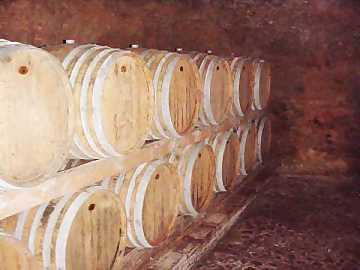 |
| A view of the cellars |
|
Let's take a look at past productions of Trappolini winery, in particular to
the wine which is well suited to aging in bottle: Paterno. Mr. Trappolini about
this aspect says «the product which has the longest story in our winery is
certainly Paterno, which was released for the first time in 1989, in a period
when talking about red wines produced in this area, which historically have
always been involved in the production of white wines, meant to swim against
the stream. However our winery owned vineyards where we were cultivating red
berried grapes and we ought to make the best possible use of them. Making a
wine to be sold non bottled, a custom pretty common among the producers of those
times, did not represent a convenient choice nor a qualitatively productive
choice. Our choice was, also according to our wine consultant, to make an
important red wine. We started experimenting with the grapes harvested in this
vineyard in order to evaluate their potentiality and then we decided to make a
red wine: Paterno. Paterno represented in this area a very prestigious and
famous wine of the 1960 which was produced by our consultant's father in a
local winery. Paterno was a wine that every one knew and every one was talking
about and was almost considered as a “myth” of the local enology. We then
decided to revive this wine and we started its production. Paterno was the name
of the area where the vineyard is located and therefore the wine was named
after that, lastly, thanks to the literal meaning of this word (“Paterno” is
Italian for “fatherly”), we believe it is the proper tribute to our father
which was the first one to change our winery production into a qualitative one,
therefore dedicating this wine to him seemed to be right. The first vintage of
the 1989 was not very encouraging, however we decided to go on, also thanks to
the introduction of new technologies. We produced 2798 bottles from the first
vintage and currently, after ten years, we produce about 30000 bottles of
Paterno, however we expect to produce about 40000 bottles with the 2000
vintage. Recently we uncorked some bottles of Paterno belonging to past
vintages and, with my surprise, one of the years which amazed me the most was
1989, not for the development of its quality, rather for the way the wine kept
its characteristics in the course of time. Paterno is aged in Allier and Nevers
barriques, that is the kind of oak, according to our opinion, that are best
suited for this wine. Paterno is aged part in casks and part in used barriques,
we never use new barriques for this wine, just because we do not want strong
wood aromas to prevail over the real and proper characteristics of the wine.
The first use of new barriques is for white wines and after that, from the
second passage on, we use them for the aging of Sangiovese.»
Let's take a look to market and countries where wines of Trappolini winery are
sold. Talking about this aspect Mr. Trappolini says «our main market is Germany
and we are also present in Switzerland, Denmark, Sweden, Brazil, Japan as well
as in Italy. Our production, quantitatively not high, does not allow us to be
present in every country and in every market, therefore we prefer to be present
in those markets which are more right for our wines.» Trappolini winery also
produces a refined grappa and Mr. Trappolini talks about its characteristics
«our winery produce raw materials, that is grape pomace, which can be processed
by distilleries in order to make grappa. It has been since a long time our
winery had the need of creating a distilled beverage in order to satisfy and
meet every gastronomical match, from wines to be matched with many foods, to
spirits to be offered at the end of a meal. The choice of pomace to be
distilled for the production of our grappa required a careful consideration;
according to a logical point of view it would have been wise distilling the
pomace of our most important product, Paterno, however we knew we had a very
particular pomace, that is the one of Aleatico which we use for the production
of Idea. We then decided to use this pomace in order to make an aromatic grappa
which was capable of meeting the taste of everyone. We subsequently found a
distiller that gave us warrants about the quality of the product and we
selected Berta distilleries in Nizza Monferrato (Italy), a renowned producer of
grappa.» The grappa produced with Aleatico's pomace has the same name of the
wine produced with these grapes: Grappa of Idea. We tasted this grappa and it
shows as crystalline and very limpid, an enchanting aroma of strawberry,
walnut, hazelnut, honey, dried rose and hints of banana, very elegant and
refined. In mouth reveals an excellent roundness where the flavors of
strawberry and dried rose are harmoniously tied and the finish is long and
pleasing. This grappa's roundness, almost velvety, is impeccably balanced by
alcohol and giving it elegance, refinement and agreeability of sure value.
|


